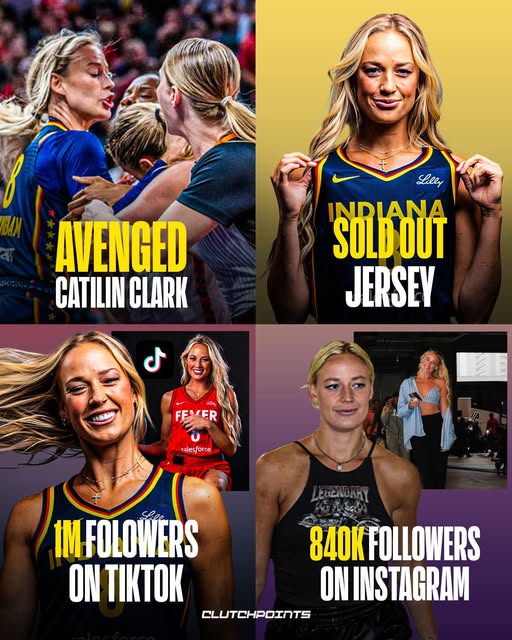Sophie Cunningham’s \$400 foul just turned into a million-dollar moment. What began as a moment of frustration on the court has transformed into a flashpoint in the WNBA spotlight, catapulting the sixth-year veteran into mainstream conversation, polarizing fan bases, and—perhaps most unexpectedly—expanding her personal brand in ways that no one, including Cunningham herself, could have predicted. In the ever-evolving narrative of women’s basketball, where moments are magnified and narratives shift by the hour, Cunningham’s now-infamous foul on Caitlin Clark has become a defining juncture not only for her but for the league at large.
It was a seemingly routine play—aggressive, physical, and fast-moving—but in today’s WNBA, where every interaction involving Caitlin Clark is dissected like the Zapruder film, nothing is ordinary. During a high-octane game between the Phoenix Mercury and the Indiana Fever, Cunningham, known for her gritty, no-nonsense style of play, delivered a hard foul on the Fever rookie while attempting to navigate a screen. The contact was ruled a flagrant, resulting in a \$400 fine, a minor slap on the wrist by professional standards. But the impact of that foul echoed far beyond the scoreboard or Cunningham’s bank account.
In the minutes, hours, and days following the incident, the clip exploded across social media. Some fans erupted in outrage, interpreting the play as emblematic of a growing resentment toward Clark’s media attention. Others defended Cunningham, praising her intensity and calling it simply “old-school basketball.” The discourse became heated, tribal, and nonstop—driving Cunningham’s name to the top of trending topics on Twitter, TikTok, and Instagram. Commentators on ESPN debated the foul’s intent, players across the league weighed in, and casual sports fans—many of whom couldn’t have named five WNBA players a month ago—suddenly had opinions on Sophie Cunningham.
But while the outrage raged, something else was happening, quietly but unmistakably: Cunningham’s Q-rating was soaring.
Before the foul, Cunningham was a respected veteran—reliable on both ends of the floor, occasionally streaky from beyond the arc, and known as a glue player. She had a loyal local following in Phoenix and among Missouri Tigers faithful, but she was far from a household name. That changed overnight. Her Instagram followers doubled within days. Sponsorship deals that had once been tepid in nature were suddenly red-hot. Apparel companies, energy drink brands, and even lifestyle labels started reaching out. Media requests poured in. And whether people loved her or loathed her, they were watching.
For Cunningham, the moment was both unexpected and instructive. In a recent interview, she acknowledged the frenzy with a chuckle, saying, “I didn’t know a \$400 fine could get me this much attention. I’ve been playing this way since college—it’s just now people are paying attention.” Her tone was defiant but also self-aware. She knew that this moment, volatile as it was, represented an opportunity—a fork in the road where her career could either embrace the spotlight or shrink from it.
She chose the former.
Cunningham leaned in, posting unapologetically on her platforms, sharing behind-the-scenes training videos, clips of game highlights with bold captions, and even memes that fans made from the Clark foul. She didn’t issue a grand apology, nor did she attempt to erase the incident from public memory. Instead, she did what the best athletes—and the savviest public figures—do: she redirected the narrative. Rather than being defined by a foul, she positioned herself as a symbol of toughness in a league that increasingly finds itself at the intersection of celebrity, media spectacle, and elite athleticism.
And people responded. Cunningham jerseys, once rarely spotted outside Phoenix, began popping up in arenas across the country. Her YouTube highlights surged in views. On TikTok, creators dubbed her “the new villain of the WNBA,” a title that in today’s viral economy is less insult than it is free marketing. She even began to receive endorsement offers tailored to her “tough girl” brand—from boxing gear companies to female-led workout apparel startups that saw her as the embodiment of modern grit.
In the WNBA, where marketing dollars are often scarce and recognition sometimes elusive, Cunningham’s rise is instructive. It shows the power of viral moments, yes—but also the power of self-possession. In an era where perception is as critical as performance, Cunningham’s ability to own the moment rather than be crushed by it is a case study in media savvy. It’s not just about the foul. It’s about how she turned it into fuel.
Of course, not all the attention has been positive. She’s faced a barrage of criticism from Clark’s supporters, many of whom feel that their favorite rookie has been unfairly targeted. Cunningham has been called everything from “dirty” to “jealous,” accusations that sting but also galvanize her supporters, who argue that men’s basketball is full of far rougher plays that go unnoticed or even glorified. It’s a point worth considering: in a league fighting for parity in both coverage and credibility, the conversation around physicality often becomes gendered. Cunningham has said as much in passing, noting, “If I were a guy, we wouldn’t even be having this conversation.”
Regardless of where one stands, the reality is clear: Cunningham has transcended her role player status. She is now part of a larger story about the WNBA’s growing pains and its breakout moments. She’s part of the Caitlin Clark phenomenon—not as a footnote, but as a catalyst. And while some may view her as the foil in Clark’s story, others see her as the proof that the league is deeper, more competitive, and more compelling than ever before.
There’s also a larger branding shift underway in the WNBA—one that Cunningham is now at the center of. For decades, the league struggled to find its marketing identity. It’s only recently, through players like A’ja Wilson, Sabrina Ionescu, Angel Reese, and yes, Caitlin Clark, that a more dynamic, socially fluent generation of stars has emerged. These players understand that being visible—being talked about—is currency. And Cunningham, whether by accident or instinct, has seized that currency.
Already, reports suggest that Cunningham is fielding pitches from podcast networks, book publishers, and even reality TV producers. What’s striking is how she has not changed her game. She’s not suddenly padding her stat sheet or chasing highlight reels. She’s still the same hard-nosed player who takes charges, hits open threes, and doesn’t back down from physical play. What’s changed is how that game is received—and what it represents.
There’s an authenticity to Cunningham that cuts through the noise. She doesn’t pretend to be anything she’s not. She’s not here to play a role or soften her edges. And in that way, she offers a kind of counterbalance to the stardom of players like Clark—less finesse, more fire. Less mainstream charm, more unapologetic force. That contrast, intentional or not, is part of what makes the WNBA narrative so rich right now.
With the season still unfolding and the Fever-Mercury rivalry heating up, there’s every reason to believe this won’t be the last time Cunningham finds herself in the national conversation. If anything, she may be just getting started. In a league where visibility matters more than ever—and where moments can define careers—Cunningham’s \$400 foul may go down as the most profitable fine in WNBA history.
What we’re witnessing is more than a viral moment. It’s a turning point for Cunningham, and perhaps for how we define success in women’s sports. Not just points and wins, but presence. Impact. Resonance. And in that arena, Sophie Cunningham is suddenly, unmistakably, a star.



